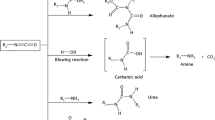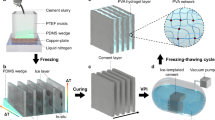Abstract
Mechanical and functional properties of a newly proposed hybrid foam based on rigid polyurethane foam and Portland cement for application in the building field are herein reported. The hybrid is characterized by the co-continuity of the two phases, hydrated cement and polyurethane, which cooperate in a synergistic way to the properties of the resulting material. Furthermore, the closed-cell foam structure gives the material properties typical of porous materials: in particular, the hybrid foam evidences thermal insulation, sound absorption and acoustic insulation, high impact energy and low density typical of polymeric foams. At the same time, the hybrid foam exhibits water vapor permeability, improvement of thermal stability, high compressive mechanical behavior, and adhesion to concrete and mortars typical of inorganic binders such as cement. The materials were obtained by mixing cement powder with polyurethane foam precursors, i.e., methylene di(phenyl-isocyanate), polyol polyether and catalysts, and silicone surfactants. Water was used as blowing reagent. The resulting compounds were foamed in flat closed molds. The cement phase was then allowed to hydrate in accelerated conditions, i.e., in water at 60 °C for 72 h. Mechanical, morphological, and functional characterization showed that the hydrated cement particles interacted with each other, forming an inorganic network within the polymeric matrix (co-continuity), thus “hydration-induced reinforcement of polymer–cement” hybrid foam, in contraposition with the term “composite foam.”






Similar content being viewed by others
References
Hilyard NC, Cunningham A (eds) (1994) Low density cellular plastics physical basis of behavior. Chapman and Hall, New York
Randall D, Lee S (eds) (2002) The polyurethanes book—Huntsman polyurethane. Wiley, New York
Kim SH, Park HC, Jeong HM, Kim BK (2010) J Mater Sci 45:2675. doi:10.1007/s10853-010-4248-3
Hararak B, Prakymoramas N, Rungseesantivanon W, Thamumjitr D (2010) In: Suttiruengwong S, Sricharussin W (eds) Advanced material research-functionalized and sensing materials. Trans Tech Publishing, Bangkok, Thailand
Nikje MMA (2010) Polym Eng Sci 50:468
Kang JW, Kim JM, Kim MS, Kim YH, Kim WN, Jang W, Shin DS (2009) Macromol Res 17:856
Yuan J, Shi SQ (2009) J Appl Polym Sci 113:2902
Tien YI, Wei KH (2002) J Appl Polym Sci 86:1741
Novak I, Krupa I, Chodak I (2002) J Mater Sci Lett 21:1039
Verdolotti L, Di Maio E, Lavorgna M, Iannace S (2006) A foamed polymer-inorganic binder hybrid material controller density and morphology, method for its preparation and uses thereof. WO2008/007187
Verdolotti L, Di Maio E, Lavorgna M, Iannace S (2008) J Appl Polym Sci 107:1
Verdolotti L, Di Maio E, Forte G, Lavorgna M, Iannace S (2010) J Mater Sci 45:3388. doi:10.1007/s10853-010-4416-5
Escalante-Garcia JI, Sharp JH (1998) Cem Concr Res 28:1245
Iñiguez-Sánchez CA, Gómez-Zamorano LY, Alonso MC (2012) J Mater Sci 41:3639. doi:10.1007/s10853-011-6210-4
Ray I, Gupta AP, Biswas M (1996) Cem Concr Compos 18:343
Taylor HFW (1997) In: Cement chemistry, 2nd edn. Thomas Telford Publishing, London
Sarier N, Onder E (2008) Thermochim Acta 452:149
Liu T, Mao L, Liu F, Jiang W, He Z, Fang P (2011) Wuhan Univ J Nat Sci 16:029
Bo L, Hong Z, Guangsu H (2007) J Mater Sci 42:199. doi:10.1007/s10853-006-1052-1
Iannace G, Masullo M, Di Maio E, Verdolotti L (2009) RIA 33:49
Beranek LL (1971) Noise and vibration control. McGraw-Hill Book Company, New York
Verdolotti L, Salerno A, Lamanna R, Nunziata A, Netti P, Iannace S (2011) Microporous Mesoporous Mater 151:79
Modesti M, Zanella L, Lorenzetti A, Bertani R, Gleria M (2005) Polym Degrad Stab 87:287
Kramer RH, Zammarano M, Linteris GT, Gedde UW, Gilman JW (2010) Polym Degrad Stab 95:1115
Lorenzetti A, Modesti M, Besco S, Hrelja D, Donadi S (2011) Polym Degrad Stab 96:1455
Siengchin S, Karger-Kocsis J, Psarras GC, Thomann R (2008) J Appl Polym Sci 110:1613
Mahfuz H, Rangari VK, Islam MS, Jeelani S (2004) Compos A 35:453
Petrovic ZS (2008) Polym Rev 48:109
Author information
Authors and Affiliations
Corresponding author
Rights and permissions
About this article
Cite this article
Verdolotti, L., Di Maio, E., Lavorgna, M. et al. Hydration-induced reinforcement of rigid polyurethane–cement foams: mechanical and functional properties. J Mater Sci 47, 6948–6957 (2012). https://doi.org/10.1007/s10853-012-6642-5
Received:
Accepted:
Published:
Issue Date:
DOI: https://doi.org/10.1007/s10853-012-6642-5




